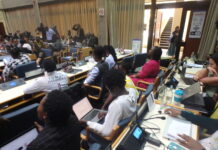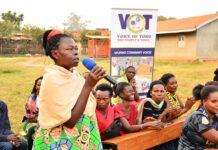By Winnie Kamau
Hundreds of households in Tanzania are now connected to the Liquefied Natural Gas (LNG) through pipes that have been linked through the fixing of a Mother Pressure Reduction Station (MPRS) which allows the gas to travel to houses and industries.
We spoke to the Acting Commissioner of Oil and Gas at the Ministry of Energy in Tanzania, Mwanamani Kidaya during the recent Regional Petroleum Conference held in Mombasa, she gave us a glance to the great progress going on in the country.
“The piping of the gas allows Tanzanians to just open the gas like the way you would open up a tap of water to access the gas, there’s no need for gas cylinders as the piped natural gas has better burning quality than the liquefied petroleum gases”
Adding “The pressure in terms of finance is only felt in the beginning when fixing the pipes in the house or industries but once connected the consumption cost is reduced close to half” explains Mwanamani.
Recent media reports indicated a majority of Dar es Salaam residents will start accessing natural gas from Mtwara for domestic use, after connecting to Ubungo plant in Dar es Salaam.

Tanzania has proven natural gas reserves of 57 trillion cubic feet, with at least 49.5 trillion cubic feet of those reserves are far offshore in the Indian Ocean
The first discovery of natural gas was made in 1974 as the country has been exploring the gases for close to 50 years.
According to Tanzania invest, a total of 67 wells for both exploration and development were drilled between 1952 and 2013, of which 53 wells are onshore and 14 are offshore basins.
The natural gas discovered both offshore and onshore are Songo Songo, which were discovered in 1974 while the second discovery, was in 1982 at Mnazi Bay.
A 512km worth 1.2billion US Dollars gas pipeline has been built from Mtwara at Mnazi Bay to Dar es Salaam. This project included the construction of Madimba Processing Centre, which is operated by the state-run gas supply company Limited (GASCO) with its first commission of gas delivery in June 2015.
The Pipeline processing plant in Mtwara is part of Tanzania’s plan to add 2,000 MW of new gas-fired power plants and bringing to a total of 10,000 MW of generation capacity by the year 2025.
The Government-owned pipeline and refinery allows the private sector to plugin and distributes to customers.

“When we produce the gas from the well it has to go through a refining plant where impurities and other gases are removed and we remain with only methane gas (CH4)” says Mwanamani.
The government also has Songo Songo, whose commercialization started in 2006 and currently Songas generates electricity-using gas from Songo Songo Island gas fields. Part of the Songas is processed from the gas field processing facility then transported to Dar es Salaam where it is used in Songas Ubongo Power Plant (UPP), the largest gas-fired power station in East Africa.
Tanzania being a Socialist Nation it is bound to protect its citizens more through its laws and regulations.
“According to the laws we are operating on, the investor can only come in on distribution. The main pipe is owned by national oil, we have the big pump where everyone who will discover gas can then plug and join that one. Why we are doing this is to avoid a lot of traffic when others want to pass their commodity. Hence the government decided to own the transportation systems then the distributors can take it from there”
Adding “The gas we produce is 98% methane (CH4) hence the by-products are little to be used for anything constructive yet. However, during processing, we get condensate oil which is used by local pharmaceuticals and we sell it at cheaper price” says the Commissioner.
The processing plants have two pipes one for local consumption and the other for international exports. The gas is at the sea but the processing plant is at the shore and each pipeline is fitted with a meter that measures the quantity allowed for LNG before distribution.

According to Africa Development Bank report pits Tanzania’s annual Gross Domestic Product (GDP) growth rate averaging at 7% over the past 5 years, making it one of the 20 fastest growing economies in the world.
Though gender parity in the male-dominated field is of great concern, Mwanamani is proud of the achievements they have had so far and wishes for more women to join the sector “Well in this field it has been male-dominated, up to date however we have some women coming up in the sector. I am very glad to be one of them, what is key is to understand that women also can work in this field. Despite having a huge role to play in society and in our families”.
With the advent of the changing technology, the staff are encouraged to do refresher courses so they are up-to-date with the new technologies in the market
“Technology changes every day so we encourage our staff to enroll in short courses to keep them at par with the latest technology. Like in the past when we used to drill we needed like forty people in the field but now it is just a computer and set measurements. This sector is very high tech we require individuals that are serious and ready to learn. It needs a lot of skills and concentration” she says.
The future is bright for Tanzania though currently according to Power Africa report shows in 2018 Tanzania had a deficit of 485 MW, with full exploitation of the Natural Gas and renewable sources, the country will have a surplus of 686MW by 2025.














